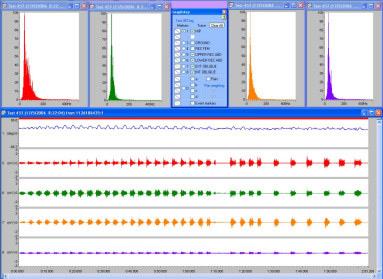Biometrics Analysis Software
The Biometrics Analysis software is a comprehensive analysis package for EMG, goniometer and other associated sensor analysis including real-time data analysis as the data is collected. It includes features to analyze captured data from the various sensors including several filters, repetitions, mean, peak value and more.
Analysis Software Features
- Compatible with Windows 10 Desktop, Laptop and Tablet
- RF Channel Optimisation Test (DataLITE)
- Complete software can operate in Chinese and Japanese
- New Delete Trace Dialogue
- Display values and units
- Conversions
- Max/Min display values in analogue inputs dialogue
- Copy marked time to a derived window
- Display video files and fully time synchronize them with data collected from DataLOG, DataLINK or DataLITE
- Expanded Results Table showing all results of all channels simultaneously
- Create and save Workspaces
- Open an unlimited number of data files with the option to track the time axis across all files allowing display and analysis for a large number of channels
- Waveform display in multiple windows and formats with full zoom, scroll, and area marking facilities, option to split, tile and cascade windows
- Waveforms within the same window may be viewed overlaid or as separate traces. Easily toggle between the two views with a simple keystroke.
- Engineering units with custom scaling ability on all traces independently
- Each recorded file is data and time stamped
- Full trace management (change line width, color, background color, etc.)
- Ability to set an unlimited number of vertical cursors (time markers) to a single trace, all traces in a window, and across multiple windows giving total flexibility. All values are shown simultaneously in the expanded results table.
- All vertical cursors may be altered via expanded results table by typing in time values to 0.001S giving maximum control.
- All horizontal cursors may be altered via expanded results table by typing in Y value to 0.01 giving maximum control.
- Filters:
- Up to six filters may be applied to each trace
- Copy filters set to a channel to all other channels in 1 simple operation
- A memory store and recall (2 memory settings) for the filters set to a channel to easily be applied to any other channel. These memory settings are kept stored indefinitely until changed by the user.
- Filters include: Rectify, Average, RMS, Velocity, Offset, Scale, Integrate, EMG Work Done, LPF 1st Order, Acceleration, Median Frequency, Mean Frequency
- Versatile Data Export for import into other applications for further analysis:
- ASCII export of raw data
- ASCII export data in engineering units
- ASCII export traces after filters have been applied in engineering units
- Wave file format
- Expanded ability to include text notes with data files
- Power Spectrum Graph
- X-Y graphs
- FFT high pass filters: remove DC, remove very low frequencies
- FFT window functions:
- Inputs and Alarms - The analogue and digital inputs are displayed in engineering units during data acquisition. Audible and visible high and/or low alarms may be set to any or all of the channels
- Comprehensive Help menu that may be used as a tutorial for both the hardware and software operations
As soon as a file is opened it is displayed as a raw EMG file and may then be subject to any or all of the features listed above. The data may be left as a whole or truncated into smaller files of specific data for further analysis. Of course, not only EMG data may be displayed at any one time. The Y axis may be labelled with any units governed by what sensors were connected at the time of recording, e.g. Kg or lbs for force or degrees for limb movement. These units are then saved with the file and automatically compute every time the file is reopened.
The digital inputs are displayed on a separate graph to the analog inputs. Using this facility during gait analysis, toe and heel contact on and off may be obtained using the contact switch assembly type no. FS4.

The Display above shows a Workspace containing unfiltered EMG data (abdominal muscles) with Goniometer data (hip flexion/extension) and EMG Power Spectrum.


